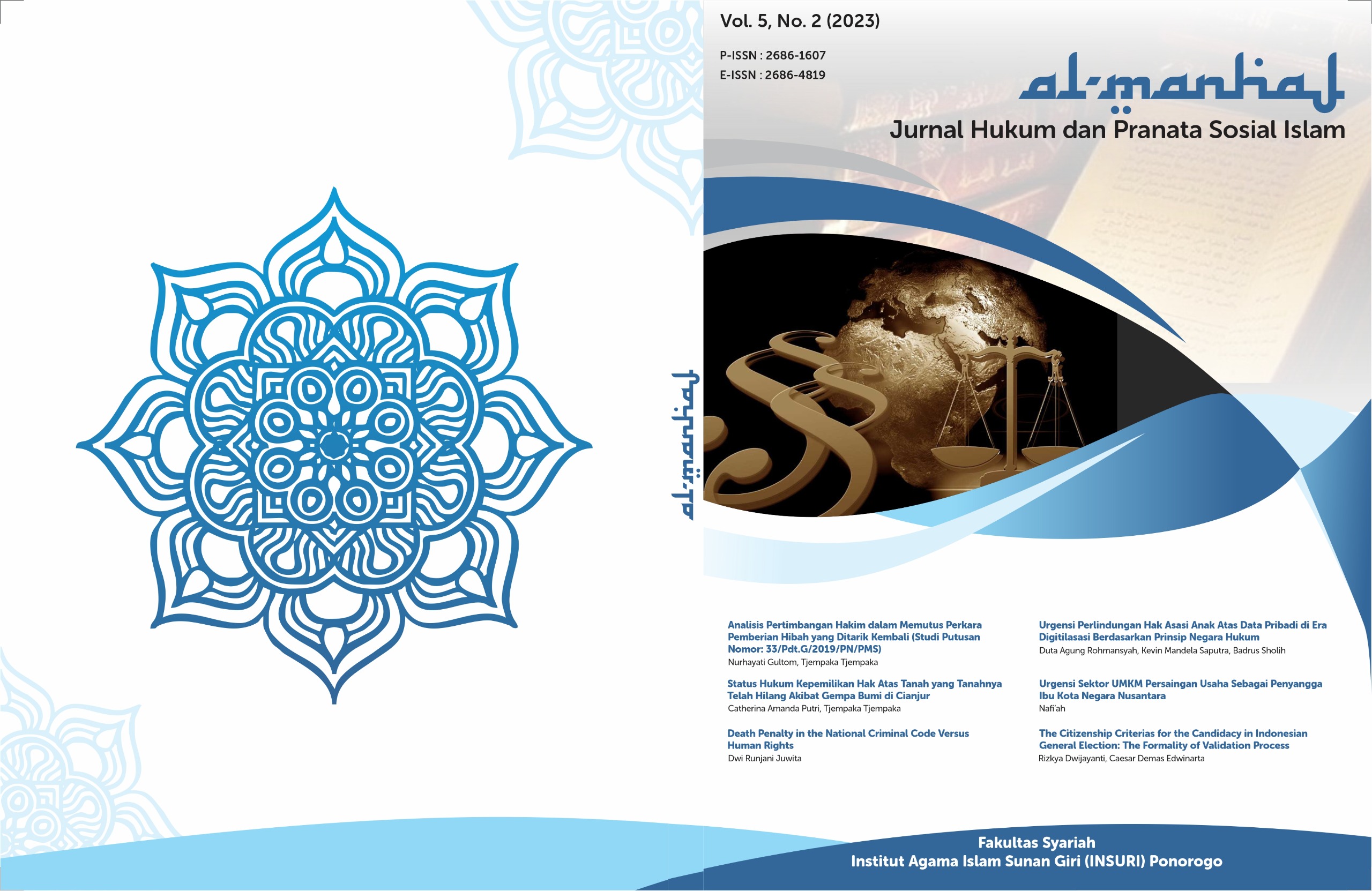Analisis Yuridis Alih Fungsi Tanah Kas Desa Untuk Pembangunan Kolam Renang di Desa Udanwuh
DOI:
https://doi.org/10.37680/almanhaj.v5i2.3354Keywords:
Juridical analysis; Land conversion; Swimming pool constructionAbstract
The aim of this research is to determine the regulation of the transfer of land to the village treasury and the obstacles of the Udanwuh Village government to building a swimming pool. The research location is at the Udanuwuh Village Hall Office, Kaliwungu District, Semarang Regency. The type of research used is an empirical juridical approach. The type of data, namely primary data, was obtained through interviews and discussions with several parties in order to provide information related to the transfer of land to the village treasury. Secondary data was obtained from library literature. Data collection techniques through literature study, interviews. Qualitative descriptive data analysis techniques. The results of the research show that the arrangement for the conversion of Village treasury land for the construction of a swimming pool in Udanwuh Village is in the form of government land in Udanwuh Village on title C Village Number 4, Plot 29 Class SII located in Ngrancah Hamlet RT.03 RW.02 village treasury land with a total area of + /- 833m2 and for the construction of swimming pools of +/-753 m2 and +/-130 m PDAM is used. Obstacles related to licensing for the conversion of village treasury land for the construction of swimming pools are based on Semarang Regency Regional Regulation No. 14 of 2003. However, with the issuance of Regional Regulation No. 21 of 2021 concerning the revocation of Semarang Regency Regional Regulation No. 14 of 2003, this has resulted in permits not being completed or delayed. The conclusion of the research is that the conversion of land functions in order to comply with applicable regulations, has a positive impact on the progress of the village, optimal management of land conversion, maximum utilization of the function of the Village treasury land into a swimming pool to improve the village economy and village community, resolving solutions to problems in make regulations regarding the transfer of cash land functions in the construction of swimming pools.
Downloads
References
Asnawi, R., Wylis Arief, R., Slameto Balai Pengkajian Teknologi Pertanian Lampung Jl Pagar Alam No, dan Z., & Lampung, B. (2022). Faktor-Faktor Penyebab Terjadinya Alih Fungsi Lahan Sawah Di Provinsi Lampung Factors Caused of Land Conversion in Lampung Province. Jurnal Wacana Pertanian, 18(1), 31–45. http://ojs.stiperdharmawacana.ac.id
Hendrawan, F. J. T., & Dewi, R. M. (2016). Analisis Dampak Alih Fungsi Lahan Pertanian Menjadi Kawasan Perumahan Terhadap Pendapatan Petani Dusun Puncel Desa Deket Wetan Lamongan. Jurnal Pendidikan Ekonomi (JUPE), 4(3), 1–10.
Hidayatullah, A. (2022). Pemberdayaan Masyarakat berbasis Ekowisata (Studi Kasus Alih Fungsi Lahan Bengkok Menjadi Ekowisata “Taman Stambran” di Desa Tambangan Kec. Mijen Kota Semarang). Jurnal At-Taghyir: Jurnal Dakwah Dan Pengembangan Masyarakat Desa, 4(2), 277–292. https://doi.org/10.24952/taghyir.v4i2.4851
H.B. Sutopo. (2006). “Metodologi Penelitian Kualitatif: Dasar Teori dan Terapannya dalam Penelitian" Surakarta, UNS Press, 1-236.
Kusumastuti, A. C., Kolopaking, L. M., & Barus, B. (2018). Faktor yang Mempengaruhi Alih Fungsi Lahan Pertanian Pangan di Kabupaten Pandeglang. Jurnal Sosiologi Pedesaa, 6(2), 130–136.
Kuswanto, H., & Diani, R. (2009). Alih Fungsi Tanah Pertanian Menjadi Non Pertanian Di Kabupaten Sidoarjo. 15–30.
Muhaimin, M. (2020). Metode Penelitian Hukum. Mataram: University Mataram Press
Mulyadi, M. (2013). Penelitian Kuantitatif Dan Kualitatif Serta Pemikiran Dasar Menggabungkannya. Jurnal Studi Komunikasi Dan Media, 15(1), 128. https://doi.org/10.31445/jskm.2011.150106
Nurhadi, I., Amiruddin, L., & Rozalinna, G. M. (2019). Produksi Ruang dan Perubahan Pengetahuan pada Masyarakat Sekitar Objek Wisata Waterland. Jurnal Kajian Ruang Sosial-Budaya, 3(1), 46–64. https://doi.org/10.21776/ub.sosiologi.jkrsb.2019.003.1.04
Oktavian, U., & Rustiadi, T. (2021). Manajemen Kolam Renang Tiara Park Waterboom Kota Jepara Purworejo. Indonesian Journal for Physical Education and Sport, 2(1), 117–123.
Prihatin, R. B. (2016). Alih Fungsi Lahan Di Perkotaan (Studi Kasus Di Kota Bandung Dan Yogyakarta). Jurnal Aspirasi, 6(2), 105–118. https://doi.org/10.22212/aspirasi.v6i2.507
Pusat, J. (2021). Alih Fungsi Lahan. Badan Pusat Statistik.
Rahmanto, L. A., Muharman, D., & Sicillia Anggraini, N. (2022). Pengendalian Alih Fungsi Lahan Pertanian Menjadi Lahan Non Pertanian Berdasarkan Undang-Undang Nomor 41 Tahun 2009. AL-MANHAJ: Jurnal Hukum Dan Pranata Sosial Islam, 4(2), 545–554. https://doi.org/10.37680/almanhaj.v4i2.1908
Retnowati, D. (2019). Upaya Pemerintah Mempertahankan Fungsi Lahan Tanah Pertanian di Kabupaten Sragen dalam Rangka Mewujudkan Kesejahteraan. Repertorium, 6(1), 1–13. https://jurnal.uns.ac.id/repertorium/article/view/27804
Ridwan, I. R. (2016). Faktor-Faktor Penyebab Dan Dampak Konversi Lahan Pertanian. In Jurnal Geografi Gea (Vol. 9, Issue 2). https://doi.org/10.17509/gea.v9i2.2448
Rodiati, E. (2015). Pengelolaan Tanah Kas Desa Dalam Rangka Meningkatkan Pendapatan Asli Desa di Desa Gegempalan Kecamatan Cikoneng Kabupaten Ciamis. In Jurnal Ilmiah iImu Pemerintahan Moderat Modern dan Demokratis (Vol. 1, Issue 1, pp. 109–120).
RPJM Desa 2019-2025. (2023).
Sonata, D. L. (2015). Dualisme Penelitian Hukum Normatif dan Empiris. Fiat Justisia Jurnal Ilmu Hukum, 8(1), 15–35.
Subagiyo, Aris; Prayitno, Gunawan; Kusriyanto, R. L. (2020). Alih Fungsi Lahan Pertanian ke Non Pertanian. Jurnal Kajian, Peneliian Dan Pengembangan Pendidikan, 8(2), 135–150.
Zainab. (2017). Dampak Sosial Ekonomi Alih Fungsi Lahan Pertanian Terhadap Masyarakat Petani (Studi Kasus Desa Tunggul Wulung, Kecamatan Lowokwaru, Malang). Jurnal Ilmiah, 11–12.
Downloads
Published
How to Cite
Issue
Section
License
Copyright:
- Author retains the copyright and grants the journal the right of first publication of the work simultaneously licensed under a Creative Commons Attribution 4.0 International License that allows others to share the work with an acknowledgment of the work's authorship and initial publication in this journal.
- Author is able to enter into separate, additional contractual arrangements for the non-exclusive distribution of the journal's published version of the work (e.g., post it to an institutional repository or publish it in a book) with the acknowledgment of its initial publication in this journal.
- Author is permitted and encouraged to post his/her work online (e.g., in institutional repositories or on their website) prior to and during the submission process, as it can lead to productive exchanges, as well as earlier and greater citation of the published work (See The Effect of Open Access).
License:
-
Attribution — You must give appropriate credit, provide a link to the license, and indicate if changes were made. You may do so in any reasonable manner, but not in any way that suggests the licensor endorses you or your use.
-
No additional restrictions — You may not apply legal terms or technological measures that legally restrict others from doing anything the license permits.
You are free to:
- Share — copy and redistribute the material in any medium or format
- Adapt — remix, transform, and build upon the material for any purpose, even commercially.

This work is licensed under a Creative Commons Attribution 4.0 International License.














